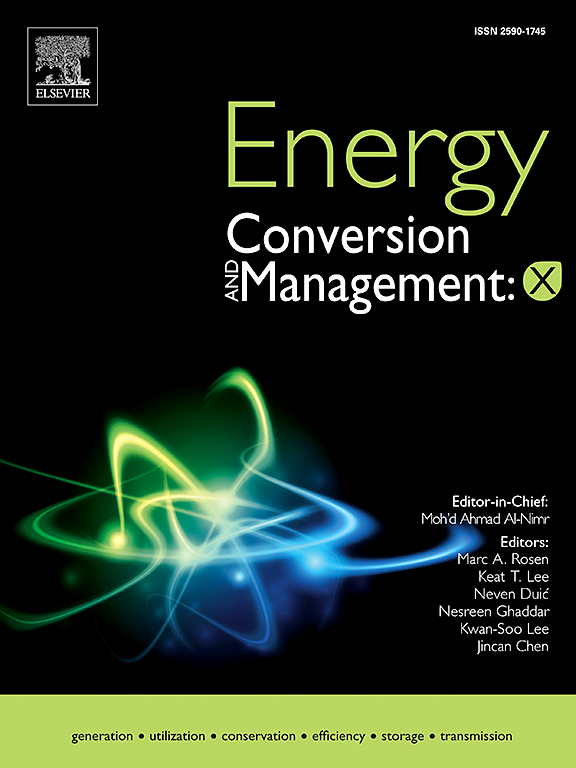Novel energy management strategy for fuel cell/battery hybrid energy systems combining MPC and deep reinforcement learning
IF 10.9
1区 工程技术
Q1 ENERGY & FUELS
引用次数: 0
Abstract
This paper proposes a novel energy management strategy (EMS) for fuel cell/battery hybrid energy systems by integrating model predictive control (MPC) with deep reinforcement learning (DRL).The proposed EMS leverages the advantages of both MPC and DRL, effectively addressing MPC’s performance degradation due to model uncertainties, while simultaneously accelerating DRL convergence and enhancing its adaptability to unforeseen conditions. Specifically, the study first formulates a dynamic model of the fuel cell/battery hybrid energy system, incorporating component degradation characteristics. Based on this, the corresponding MPC model is then developed. MPC serves as the baseline controller, ensuring system stability and constraint adherence through a linearized model, while DRL provides a compensatory policy to enhance the system’s long-term decision-making capability. The combined control strategy is applied to optimize the hybrid energy system, with objectives carefully designed to balance state of charge (SOC) maintenance, hydrogen consumption, and degradation costs of each energy source. Simulation results demonstrate that the proposed control strategy outperforms both the standalone MPC-based EMS and the DRL-based EMS across multiple performance indicators. Compared to MPC, the proposed strategy results in a 4.41 % increase in battery degradation but achieves a significant 51.43 % reduction in fuel cell degradation. Moreover, while maintaining battery SOC, it achieves the lowest system operating cost, reducing it by 4.45 % and 2.13 % compared to MPC and DRL, respectively. Furthermore, comparative analyses with classical EMSs and validations under unknown scenarios further highlight the robustness and overall performance advantages of the proposed strategy.
结合MPC和深度强化学习的燃料电池/电池混合能源系统能量管理新策略
本文提出了一种将模型预测控制(MPC)与深度强化学习(DRL)相结合的燃料电池/电池混合能源系统能量管理策略(EMS)。所提出的EMS利用了MPC和DRL的优点,有效地解决了MPC由于模型不确定性而导致的性能下降问题,同时加速了DRL的收敛并增强了其对不可预见条件的适应性。具体而言,该研究首先建立了燃料电池/电池混合能源系统的动态模型,并考虑了组件的退化特性。在此基础上,建立了相应的MPC模型。MPC作为基准控制器,通过线性化模型确保系统稳定性和约束依从性,而DRL提供补偿策略,增强系统的长期决策能力。该组合控制策略用于优化混合能源系统,并精心设计目标,以平衡每种能源的荷电状态(SOC)维持、氢消耗和降解成本。仿真结果表明,该控制策略在多个性能指标上都优于独立的基于mpc的EMS和基于drl的EMS。与MPC相比,该策略导致电池退化率增加4.41%,但燃料电池退化率显著降低51.43%。此外,在保持电池SOC的同时,实现了最低的系统运行成本,与MPC和DRL相比,分别降低了4.45%和2.13%。此外,与经典EMSs的对比分析和未知场景下的验证进一步突出了所提出策略的鲁棒性和整体性能优势。
本文章由计算机程序翻译,如有差异,请以英文原文为准。
求助全文
约1分钟内获得全文
求助全文
来源期刊

Energy Conversion and Management
工程技术-力学
CiteScore
19.00
自引率
11.50%
发文量
1304
审稿时长
17 days
期刊介绍:
The journal Energy Conversion and Management provides a forum for publishing original contributions and comprehensive technical review articles of interdisciplinary and original research on all important energy topics.
The topics considered include energy generation, utilization, conversion, storage, transmission, conservation, management and sustainability. These topics typically involve various types of energy such as mechanical, thermal, nuclear, chemical, electromagnetic, magnetic and electric. These energy types cover all known energy resources, including renewable resources (e.g., solar, bio, hydro, wind, geothermal and ocean energy), fossil fuels and nuclear resources.
 求助内容:
求助内容: 应助结果提醒方式:
应助结果提醒方式:


